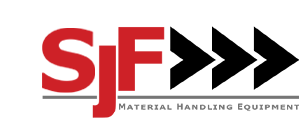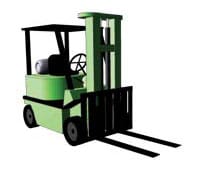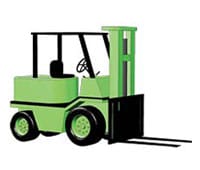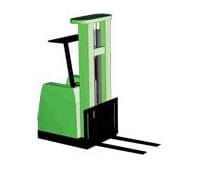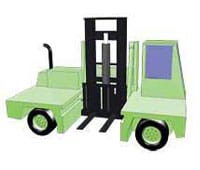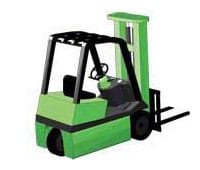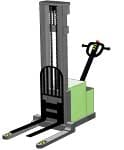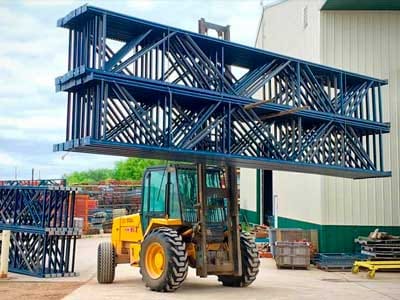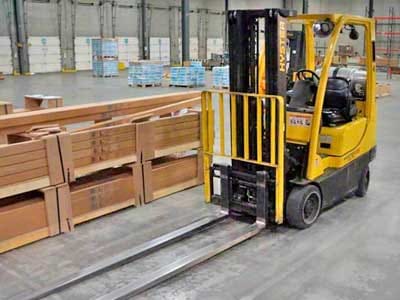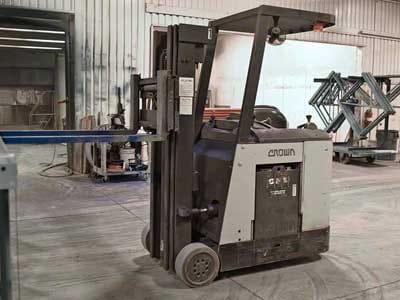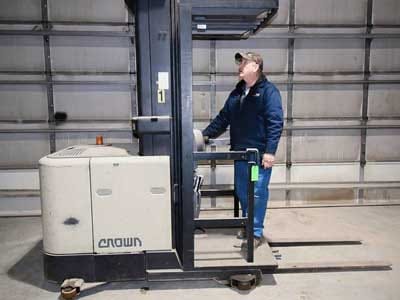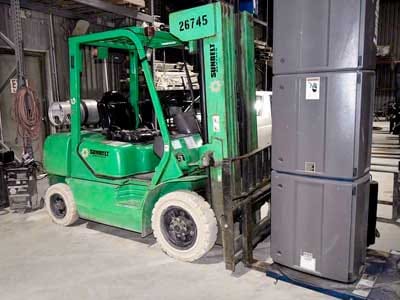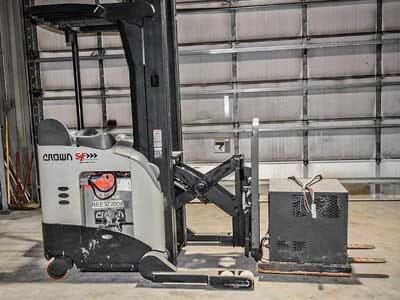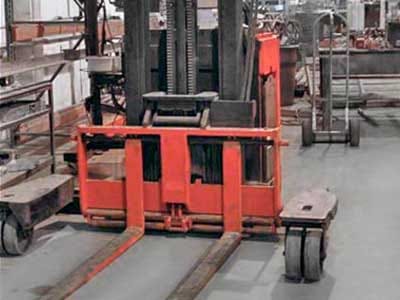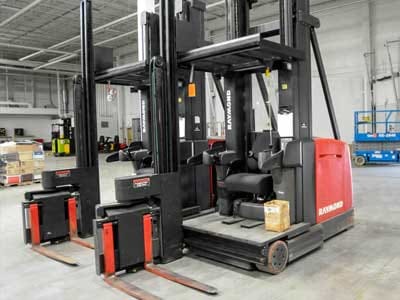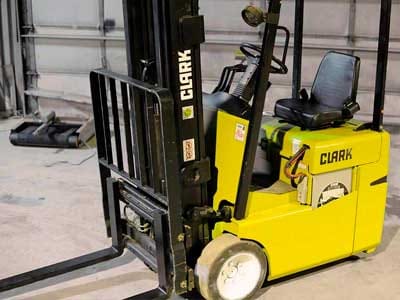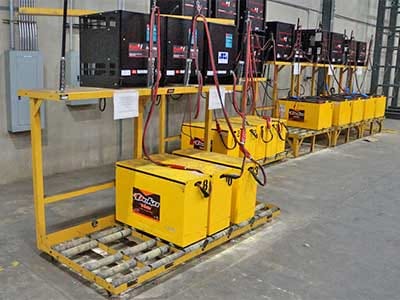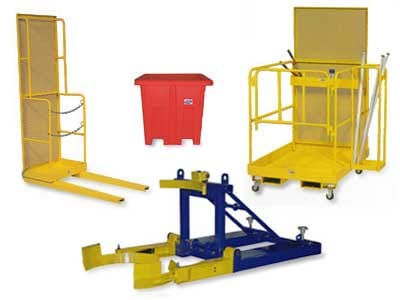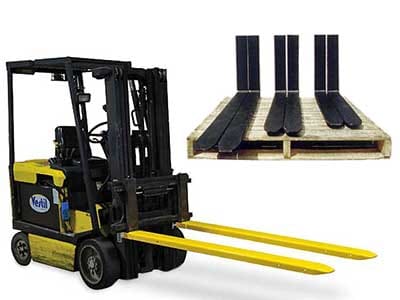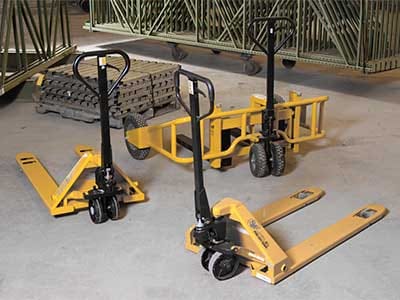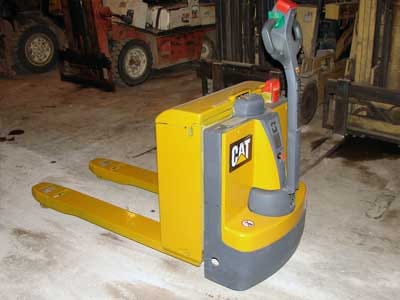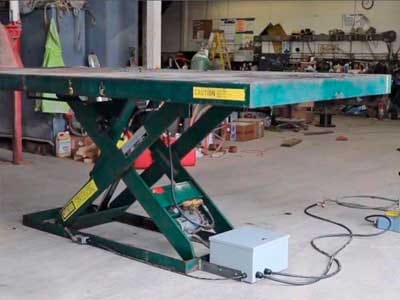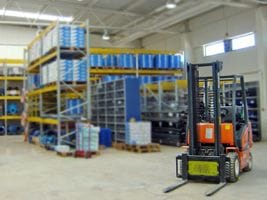Types of Forklifts & Their Material Handling Applications
All Terrain & Rough Terrain Forklifts
All terrain and rough terrain forklifts are the preferred heavy equipment forklift type for construction sites, ranches, farms and other outdoor environments and are usually powered by an internal combustion engine, such as gas or diesel. These all terrain forklift trucks excel at taking steep slopes and transitioning from gravel or another uneven surface to smooth and even surfaces. They also offer many different options for operator comfort and forklift safety, such as enclosed cabs, automatic transmission and safety bars.
All terrain and rough terrain forklifts are typically lower to the ground than other forklift builds for lighter operations and they appear to have a regular truck chassis rather than a typical forklift frame. In addition, these forklifts usually have a larger wheelbase (width + length) and articulating forks, oftentimes on hydraulic boom lifts forklift attachments.
Where typical fork trucks need to approach a load head-on and on a flat even surface, an all terrain or rough terrain forklift can pick up a load even when the load is on a slope or otherwise unusually positioned. All terrain forklifts are great for factories or warehouses that prefer internal combustion material handling equipment for inventory located outdoors on rough surfaces.
Cushion Tire Forklifts
Cushion tire forklifts (also known as hard tire gas or electric trucks) are great for anybody that needs a good indoor only fork lift. These trucks are designed for indoor use and the power source is usually propane, LP, gas or electric power. Electric cushion wheel fork lifts require forklift batteries and forklift battery chargers.
Cushion tire lifts are ideal for driving on a wide variety of surfaces such as smooth concrete and blacktop. Though they have trouble on rough surfaces, cushion tire forklifts are exceptional when driving on smooth surfaces. The cushion tires that support these lifts are typically smaller and made of a hard rubber compound and, as such, will not puncture and require less maintenance than a pneumatic tire.
These pallet trucks also tend to be more compact and maneuverable than pneumatic tire models, but they will absorb fewer shocks than pneumatic tire forklifts. Besides being highly versatile, these lifts can be found with load capacities ranging up to 15,000 lbs.
Pneumatic Tire Forklifts
Pneumatic forklifts feature tires that are filled with air and fastened to a rim – just like automobiles. The size of these tires and their composition depends on exactly what the pneumatic forklift will be used for. Likewise, the load capacity of a pneumatic forklift will be determined by the air pressure and volume of air inside the tires.
Low pressure pneumatic tires have a large volume of air with a lower air pressure. This combination gives the tires a large footprint, which reduces the pressure exerted on the warehouse floor, increasing operator safety. It also increases shock absorption, which leads to a higher degree of comfort for the operator. These pneumatic tires work well on poor quality floors.
High pressure pneumatic tires have a small volume of air at a higher air pressure. This combination gives the tires a small footprint and center control, which increases the pressure exerted on the warehouse floor. It also decreases shock absorption, which leads to a lesser degree of comfort for the operator. These pneumatic tires work well on solid, good quality floors.
Narrow Aisle, Stock Picking& Scissors Reach Forklifts
Narrow aisle forklifts are made for use on smooth, level warehouse floors when you need to pick and stock product in very cramped aisles of racking. Aisle widths of 8-1/2 to 12 feet can be easily navigated with these lifts, as they are designed to have a small turning radius. These lifts usually feature a cab for a standup rider rather than sit down forklift operations. This is done not only to keep the forklift narrow enough to fit down small aisles, but also helps the operator get a better view of the product being picked or stocked. These forklifts can be found with scissors reach attachments as well as with straddle arms.
A scissors reach attachment allows the forklift to reach into deep racking to pick and stock several feet in front of the truck's chassis. A heavy-duty scissors reach mechanism can extend and retract at the push of a button and allow the reach truck's operator to reach the forklift's forks into the storage rack. Some scissors reaches can extend to as far as two-pallet loads deep, making product that is set double-deep easy to reach. Scissor lifts reach trucks must either be a counterbalanced truck or have straddle arms to offset the weight of the load upon the fork extensions, although a scissor lifts reach mechanism can extend beyond the straddle arms' length.
Straddle trucks (order and stock picking trucks) are fitted with arms that extend outward underneath the forks in order to support a load. These straddle arms have wheels that function as the load wheels while the rear wheel will swivel in place to facilitate turning the straddle truck. This type of forklift requires room for the straddle arms at the base of the racking you are using. This clearance must be provided for the straddle truck to be able to lift a load. The arm clearance can be provided by a number of means including a low level beam to keep bottom load off floor, single wing pallets or other spacer options that would keep the floor clear for the straddle arms. Straddle trucks are typically less expensive than a regular counterbalance or narrow aisle lift truck.
Order Picker Forklifts
An order picker is a type of lift truck that features an elevating platform for the truck's operator. This platform allows the operator to be raised into the air, which facilitates less-than-unit-load picking or stocking. The operator essentially is lifted or lowered to the height of the pick or stock position with the load in order to get access to the product. The lift platform doubles as the stocking/picking platform as well as the order picker's driver cab. The platform itself is integrated with the load carrying unit (forks) and the mast.
Often, the cab of an order picker features what is known as a "dead man's switch." This operator safety switch (which can be a pedal or other special safety harness) will prevent the order picker from moving unless activated by the industrial truck operator. The operation of this switch is designed with forklift safety in mind so that movement of the forklift is not possible while the operator is stocking or picking.
Swing Reach Forklifts - Turret Trucks
Swing reach forklifts (sometimes known as swing reach turret trucks) are a great solution if you need a lot of maneuverability in tight spaces. These narrow, compact trucks feature a swing-reach mast that allows the lift operator to turn the forks sideways in order to retrieve or place a load. Once the forks are swung to the side on the electric reach truck, they can be extended to reach into your storage racking.
When the swing reach forklift has the product on the forks, it can then swing the load back out to the front of the truck and raise and lower the forks like a regular forklift truck. When the load is on the forks, it can be rotated a full 180 degrees. A big advantage of swing reach and turret trucks is that because they can rotate their forks 180 degrees, they can stock and pick from both sides of an aisle without having to turn the entire forklift around.
Swing reach forklifts and turret trucks come in either operator up (shown) or operator down models for different applications. With a man-up swing-reach truck, the forklift's mast is fixed to the truck body and the driver's cab lifts with the load to allow for order selection. A man-down turret truck is exactly the same except the forklift's operator does not go up and down with the load. Some man-down swing-reach forklifts will also only allow for 180 degree movement and cannot place loads directly in front of the forklift.
Sideloader Forklifts
A sideloader forklift lifting truck makes a great choice when picking wide or long loads in narrow aisles with limited maneuverability space. The side-loader forklift is ideally suited for handling long bulky items in cramped aisles with high pallet stacker capacity.
Sideloaders are unique in that they feature forks that are mounted perpendicular to the direction that the forklift travels. These side-mounted forks are pivotal for picking and stocking long product in narrow aisles with limited space. Sideloader forklifts can lift to a max lift height of 30 feet with capacities of up to 10,000 lb capacity. Sideloaders are particularly good for handling tubing, paper rolls, pipes, bar stock, plywood sheets and other long goods in an efficient and safe manner.
Generally, there are two main types of side-loaders: A sit-down model (shown) with an enclosed cab would typically be used for outdoor applications (lumber yards, etc.) while a stand-up type sideloader would be more useful in an indoor setting.
Three Wheel Forklifts
Three wheel forklifts are typically electric forklift trucks and counterbalanced with a triangular wheel base. These forklifts have three wheels – two in front and one center wheel in the rear. The rear wheel can be either a single or double wheel and provides the steering for the forklift, while the two front wheels provide the drive, or traction.
The rear (steering) wheel of a three wheel forklift can be turned up to 90 degrees in either direction. This movement provides exceptional maneuverability in tight spaces. In fact, one of the biggest advantages of a three wheel forklift compared to similarly sized four wheel trucks is that the three wheel forklift has a much tighter turning radius than a four wheeled truck that is roughly the same size. Three wheel forklifts can also be considerably lighter weight than similar four wheel models. Three wheel forklift trucks are very efficient when used on smooth concrete floors.
Walkie Stacker Lift (or Walk-Behind Stackers)
Both walk-behind and rider models offer superior versatility and ease of operation. These are good entry-level lifts for those who need a small to moderate lifting solution. Load capacities of up to 4,000 lbs. are available.
